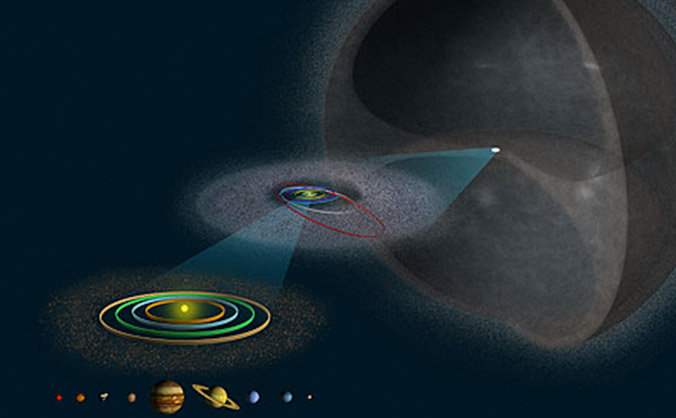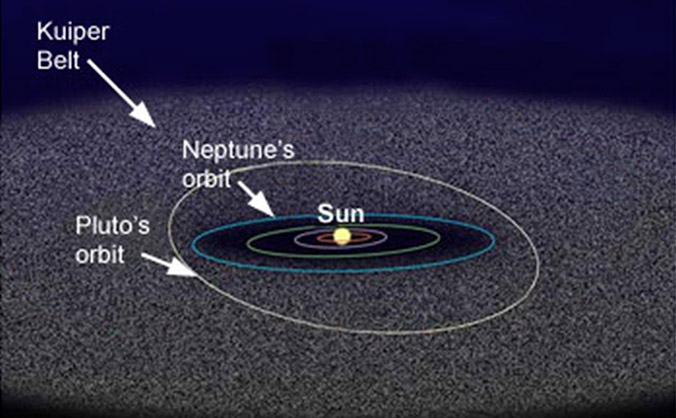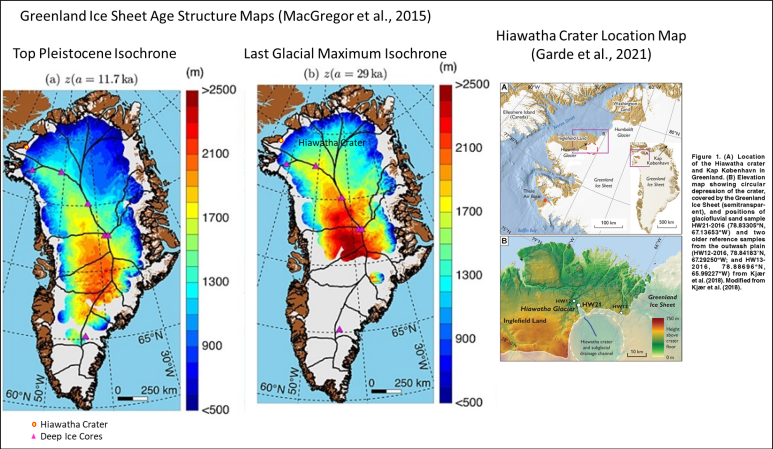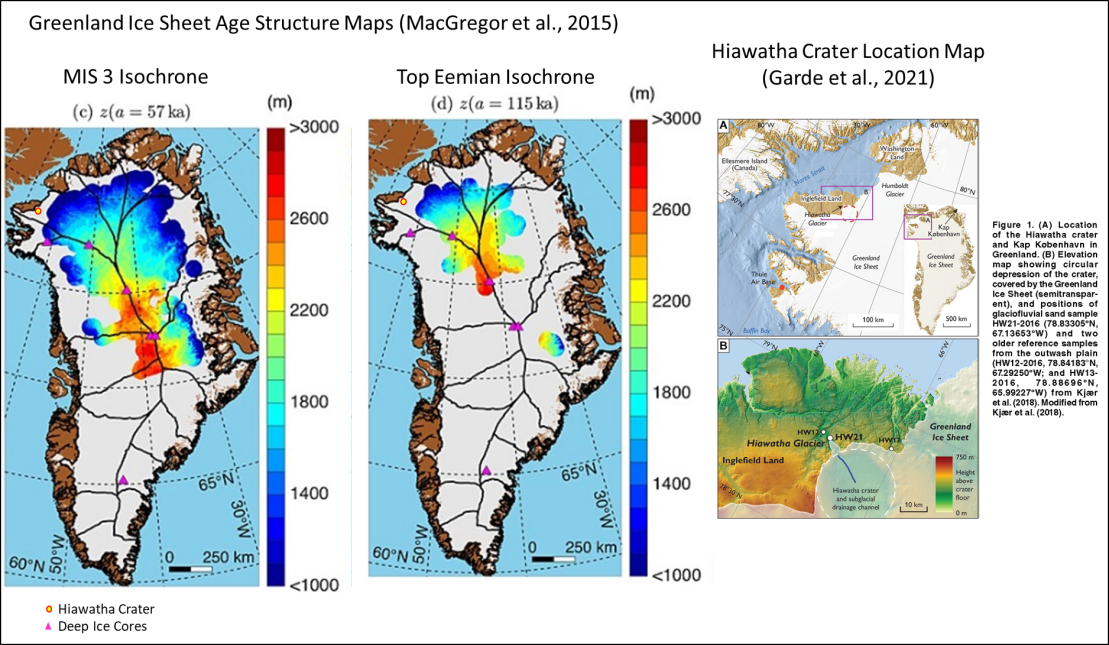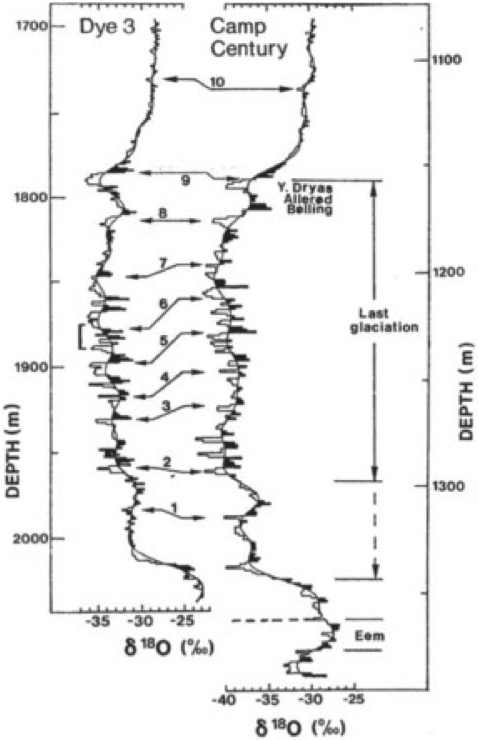Their modeling indicated if the impact occurred on a relatively
thick ice sheet (>1.5 km), the ejection of rocky material would be inhibited, possibly explaining
why no fragments have been identified in any of the deep ice cores. In the pre-impact ice cover model, only the closest ice core, Camp Century,
would have a significant accumulation of ejecta material. They went on to note Glacial Isostatic Adjustment (GIA) models indicate that Hiawatha Glacier
has not been >1 km thick over the past 26,000 years.
While they couldn’t categorically rule out a Late Pleistocene impact on the ice sheet, they concluded that
rocky ejecta fragments should have been found in the Camp Century ice core; and so far, no ejecta material has been found.
While not directly related to the Hiawatha Crater, I ran across another very interesting new bit of research on the Camp Century ice core. Two of the authors discussed it in in this article:
Ancient leaves preserved under a mile of Greenland’s ice – and lost in a freezer for years – hold lessons about climate change
Andrew Christ & Paul Bierman, March 15, 2021
In 1963, inside a covert U.S. military base in northern Greenland, a team of scientists
began drilling down through the Greenland ice sheet. Piece by piece, they extracted
an ice core 4 inches across and nearly a mile long. At the very end, they pulled up something else –
12 feet of frozen soil.
The ice told a story of Earth’s climate history. The frozen soil
was examined, set aside and then forgotten.
Half a century later, scientists rediscovered that soil i
n a Danish freezer. It is now revealing its secrets.
Using lab techniques unimaginable in the 1960s when the core was drilled, we and an international team of fellow scientists were able to show that Greenland’s massive ice sheet had melted to the ground there within the past million years. Radiocarbon dating shows that it would have happened more than 50,000 years ago. It most likely happened during times when the climate was warm and sea level was high, possibly 400,000 years ago.
And there was more. As we explored the soil under a microscope, we were stunned to discover
the remnants of a tundra ecosystem – twigs, leaves and moss. We were looking at northern Greenland as it existed the last time the region was ice-free. Our
peer-reviewed study was published on March 15 in
Proceedings of the National Academy of Sciences.
[…]
Dating million-year-old moss
How old were these plants?
Over the last million years, Earth’s climate was punctuated by relatively short warm periods, typically lasting about 10,000 years, called interglacials, when there was less ice at the poles and sea level was higher. The Greenland ice sheet survived through all of human history during the Holocene, the present interglacial period of the last 12,000 years, and most of the interglacials in the last million years.
But our research shows
that at least one of these interglacial periods was warm enough for a long enough period of time to melt large portions of the Greenland ice sheet, allowing a tundra ecosystem to emerge in northwestern Greenland.
We used two techniques to determine the age of the soil and the plants. First, we used
clean room chemistry and a
particle accelerator to count atoms that form in rocks and sediment when exposed to natural radiation that bombards Earth. Then, a colleague used an ultra-sensitive method for measuring
light emitted from grains of sand to determine the last time they were exposed to sunlight.
The million-year time frame is important.
Previous work on another ice core, GISP2, extracted from central Greenland in the 1990s, showed that the ice had also been absent there within the last million years, perhaps about 400,000 years ago.
[…]
The Conversation
The location of the Camp Century ice core was ice-free and vegetated from ~2.7 to ~1.4 million years ago and then again within the past 1 million years. Dr. Christ was kind enough to send me a copy of his paper…
Some really cool geological detective work!
Getting back to the Hiawatha Crater, Garde et al., 2020 (many of the same authors of Kjær et al., 2018) identified organic material, including charcoal and lignite, in the outwash from the crater. The material was too old to be reliably 14C dated. One of the lignite lumps “yielded a non-finite 14C age of >43,500 yr B.P.”
The material appears to be consistent the climatic conditions of the Late Pliocene to Early Pleistocene.
Origin and Age of the Organic Matter
Our observations and analyses of the organic carbon in front of the Hiawatha Glacier show that it stems from organic-rich beds formed at a time when tree growth at this high northern latitude was possible. Pliocene to early Pleistocene deposits at ∼80°N are known, e.g., from the 2.4 Ma Kap København Formation in North Greenland (Funder et al., 2001) and the adjacent ca. 3 Ma Beaufort Formation at Meighen Island, Canada (Fyles et al., 1991).
[…]
The early Pleistocene, 2.4 Ma, Kap København Formation in North Greenland is the youngest known occurrence of forest at these high latitudes (see Funder et al. [2001] regarding the 2.4 Ma age determination), and the absence of Pinus does not preclude contemporaneous growth in Inglefield Land some 200 km to the south. In summary, the age of the organic carbon at Hiawatha is probably 3–2.4 Ma, and we favor the younger, 2.4 Ma age as the simplest interpretation and a realistic maximum age of the impact.
[…]
Garde et al., 2020
Since we don’t know if the Pleistocene organic material came from trees and other biomass incinerated by the impact 2.4 Ma or were the remains of plants buried under the ice sheet and incinerated more recently by an impact event, we can’t fix the minimum age from these data.
An impact through the ice sheet during the Late Pleistocene
should have been detectable in the Camp Century ice core; however no ejecta fragments have been identified. An impact 3 million years ago, should have deposited rocky ejecta fragments at the Camp Century location and these should have been present in sediment samples from Christ et al, 2021.
They don’t appear to be present.
Could the impact have occurred between the Camp Century ice-free periods (~1.4 to 0.9 Ma)?
This ice would have melted, possibly washing away the fragments. This age range works for all of the papers discussed so far.
What if the impact had occurred during the last Pleistocene glacial stage?
As noted earlier, models indicate that a relatively thick ice sheet at the impact site would have muted the ejecta. Based on Silber et., al 2021, the total volume of ice melted would be less than 1,000 km3. It actually might not have left much of a mark on the ice sheet.
We do know from Kjær et al., 2018 that the Top/Pleistocene radar reflector is not present in the Hiawatha Crater. Of course, we wouldn’t expect it to be present. The peripheral ice is either Holocene aged or of unknown age due to deformation.
In the maps below, on the two leftmost panels, Hiawatha Crater is marked by the yellow dot, with a red outline. The deep ice cores are marked with magenta triangles. If you open the image, it will be easier to see. Camp Century is the magenta triangle closest to the crater
Top/Pleistocene and Last Glacial Maximum Age Structure Maps and Hiawatha Crater (
click to enlarge).
The structure maps are of the Top/Pleistocene and Last Glacial Maximum isochrones. They were constructed from ice penetrating radar profiles (
MacGregor et al., 2015). If the impact occurred during the the latter part of the last glacial stage of the Pleistocene,
it had no effect on the ice sheet just a few 10’s of kilometers away.
Had the impact occurred before the last glacial maximum, there shouldn’t be any evidence of it in the Camp Century ice core.
MIS 3 and Top/Eemian Age Structure Maps and Hiawatha Crater (
click to enlarge).
The manner in which these scientists tie the ice cores into the radar profiles and interpret the ice sheet’s internal structure and stratigraphy is very analogous to the way we tie well logs into seismic profiles and interpret the structure and stratigraphy of Earth’s subsurface.
This
NASA video on Operation Ice Bridge is a pretty good depiction of how ice penetrating radar has been used to map the stratigraphy of the Greenland Ice Sheet.
Conclusions
The age range for the Hiawatha impact that best accommodates all of the data and models is 1.4 to 0.9 million years ago. While a more recent impact cannot be absolutely ruled out;
there should have been evidence for it in the Camp Century ice core. Even if the impact did occur during the latter part of the last glacial stage (29 to 11.7 thousand years ago),
it had no material effect on the ice sheet. The Camp Century ice core is easily correlated to the ice core most distant from the impact. This would not be the case if impact had significantly melted and/or disrupted the Late Pleistocene ice sheet at Camp Century.
δ18O-profiles along the deepest, 300 m, of the surface to bedrock ice cores from Dye 3 and Camp Century. Credit: Willi Dansgaard.
Geochronology/Ice cores
The only clear evidence for a recent (past 29 ka) impact found in Greenland (so far) is the platinum anomaly in the GISP2 ice core (Petaev et al., 2013); although this does not necessarily mean the impact occurred in Greenland. Late Pleistocene platinum anomalies have also been identified in North America (Moore et al., 2017) and South Africa (Thackeray et al., 2019). Some scientists have interpreted these platinum anomalies to be of volcanic origin (Sun et al, 2020). So the evidence remains equivocal.
Lessons Learned
- I incorrectly assumed that an impact during the last Pleistocene glacial stage would have had a catastrophic effect on the ice sheet. The models indicate that it wouldn’t have and the ice cores exhibit no evidence of such catastrophic effects.
- I initially read Garde et al., 2020 as an age bracket. It only strictly limits the maximum age.
- An impact at the onset of the Younger Dryas can’t be categorically ruled out. However, the ice sheet would have muted the effects of the impact. If the impact did not materially affect the Greenland Ice Sheet, it probably didn’t do a lot of damage elsewhere. This is still not the crater you are looking for.
References
Note: I did not incorporate all of these references into this post. However, since I gathered them while writing this post, I listed them for future reference. Badgely et al., 2020 is a useful collection ice ice core δ18O data. Dyke et al., 2003 and Dyke 2004 present an excellent set of ice front maps over North America during the deglaciation period.
Badgeley, Jessica A., Eric J. Steig, Gregory J. Hakim, and Tyler J. Fudge. 2020.
Reconstructions of mean-annual Greenland temperature and precipitation for the past 20,000 years and the ice-core records used to create the reconstructions 2020. Arctic Data Center.
doi:10.18739/A2599Z26M.
Christ, A.J., Bierman, P.R., Schaefer, J.M., Dahl-Jensen, D., Steffensen, J.P., Corbett, L.B., Peteet, D.M., Thomas, E.K., Steig, E.J., Rittenour, T.M., Tison, J-L., Blard, P-H., Perdrial, N., Dethier, D., Lini, A., Hidy, A.J., Caffee, M., Southon, J., in press, “
A multi-million-year-old record of Greenland vegetation and glacial history preserved in sediment beneath 1.4 km of ice at Camp Century”,
The Proceedings of the National Academies of Sciences of the United States of America.
Dyke, A.S., Moore, A. and L. Robertson. [computer file].
Deglaciation of North America. Geological Survey of Canada Open File 1547. Ottawa: Natural Resources Canada, 2003.
Dyke, Arthur. (2004). An outline of North American deglaciation with emphasis on central and northern Canada.
Developments in Quaternary Sciences. 2. 10.1016/S1571-0866(04)80209-4.
Garde, Adam A., Anne Sofie Søndergaard, Carsten Guvad, Jette Dahl-Møller, Gernot Nehrke, Hamed Sanei, Christian Weikusat, Svend Funder, Kurt H. Kjær, Nicolaj Krog Larsen;
Pleistocene organic matter modified by the Hiawatha impact, northwest Greenland.
Geology 2020;; 48 (9): 867–871. doi:
Pleistocene organic matter modified by the Hiawatha impact, northwest Greenland | Geology | GeoScienceWorld
Kjær, Kurt, Larsen, Nicolaj, Binder, Tobias, Bjørk, Anders, Eisen, Olaf, Fahnestock, Mark & Funder, Svend & Garde, Adam & Haack, Henning & Helm, Veit, Houmark-Nielsen, Michael, Kjeldsen, Kristian, Khan, Shfaqat, Machguth, Horst, Mcdonald, Iain, Morlighem, Mathieu, Mouginot, Jeremie’ Paden, J., Waight, Tod & MacGregor, Joseph. (2018). “
A large impact crater beneath Hiawatha Glacier in northwest Greenland”.
Science Advances. 4. eaar8173. 10.1126/sciadv.aar8173.
MacGregor, J. A., Fahnestock, M. A., Catania, G. A., Paden, J. D., Prasad Gogineni, S., Young, S. K., Rybarski, S. C., Mabrey, A. N., Wagman, B. M. and Morlighem, M. (2015),
Radiostratigraphy and age structure of the Greenland Ice Sheet. J. Geophys. Res. Earth Surf., 120: 212– 241. doi:
10.1002/2014JF003215.
Moore, C., West, A., LeCompte, M.
et al. Widespread platinum anomaly documented at the Younger Dryas onset in North American sedimentary sequences.
Sci Rep 7, 44031 (2017).
https://doi.org/10.1038/srep44031
NEEM community members.
Eemian interglacial reconstructed from a Greenland folded ice core.
Nature 493, 489–494 (2013).
https://doi.org/10.1038/nature11789
Petaev, Michail I., Shichun Huang, Stein B. Jacobsen, Alan Zindler. “
Large Pt anomaly at the onset of the Younger Dryas”.
Proceedings of the National Academy of Sciences Aug 2013, 110 (32) 12917-12920; DOI: 10.1073/pnas.1303924110
Silber, E. A., B. C. Johnson, E. Bjonnes, et al. 2021. “
Effect of ice sheet thickness on formation of the Hiawatha impact crater.” Earth and Planetary Science Letters,
566: 116972 [
10.1016/j.epsl.2021.116972]
Sun, N., Brandon, A.D., Forman, S.L., Waters, M.R., Befus, K.S., 2020.
Volcanic origin for Younger Dryas geochemical anomalies ca. 12,900 cal B.P. Science Advances 6, eaax8587.
Thackeray, J. Francis; Scott, Louis; Pieterse, P. The Younger Dryas interval at Wonderkrater (South Africa) in the context of a platinum anomaly.
Palaeontologia Africana, 2019


